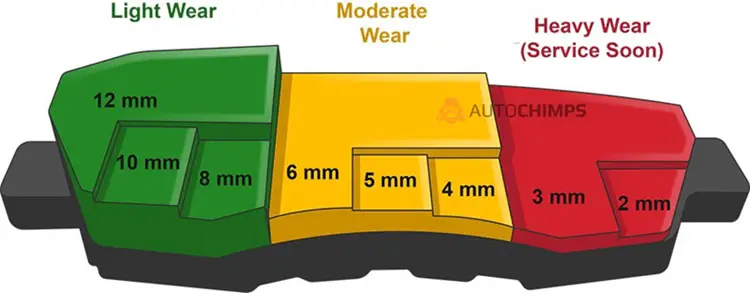A brake pad thickness chart is a tool used to assess the remaining material on brake pads and determine when they need replacement. New brake pads typically measure 10-12 mm, and they should be replaced when they wear down to 3 mm or less.
Brakes are among the most critical safety components of any vehicle, and brake pads are central to their operation. Over time, brake pads wear down due to friction, and monitoring their thickness is vital for ensuring safe braking performance.
This guide will delve into brake pad thickness, explain what a brake pad thickness chart is, how to use it, and answer some frequently asked questions about brake pad wear.

Contents
What is a Brake Pad Thickness Chart?
A brake pad thickness chart is a reference guide that helps drivers and mechanics determine whether brake pads have enough material left to function safely or need to be replaced. The chart typically includes a visual or numerical scale indicating the thickness of the brake pad material and corresponding recommendations for replacement or maintenance. Most charts display the following categories:
- New or Optimal: Brake pads that are in good condition and do not need replacement.
- Moderate Wear: Pads that are showing signs of wear but are still functional.
- Critical Wear: Pads that have reached a point where replacement is urgent to prevent damage to other braking components and to ensure driver safety.
The new brake pad thickness is generally between 10 to 12 millimeters (mm), and they should be replaced when they reach a critical level of about 3 mm. However, the specific recommendations might vary based on the type of vehicle, driving conditions, and brake pad material.
Brake Pad Thickness
brake pad thickness is essential for maintaining vehicle safety and brake performance. Here’s a guide to understanding brake pad thickness –
New Brake Pads
When brake pads are new, they typically have a thickness of 10 to 12 mm. This ensures adequate material to withstand the wear caused by braking friction over time. Brake pads are made of durable materials, such as semi-metallic, organic, or ceramic composites, which vary in durability and performance.
Moderate Wear (7-8 mm)
At around 7-8 mm, brake pads are considered to be in good working condition, but drivers should start monitoring their wear more closely. Regular brake inspections are essential, especially if the vehicle is driven in stop-and-go traffic or under heavy loads.
Critical Wear (3 mm)
Once brake pads reach 3 mm of thickness, they are considered critically worn and should be replaced immediately. At this level, the brake pads are too thin to provide sufficient stopping power and may compromise the performance of the braking system, leading to longer stopping distances or even brake failure.
Dangerous Levels (1-2 mm)
At 1-2 mm, the brake pads are dangerously thin and may cause damage to other components of the braking system, such as the rotors. Driving with pads this worn can result in unsafe driving conditions and significantly increase the risk of an accident.

Using a Brake Pad Thickness Chart
A brake pad thickness chart is an invaluable tool for understanding when your pads are due for replacement. Here is an example of a typical chart:
| Brake Pad Thickness | Condition | Action Needed |
|---|---|---|
| 10-12 mm | New | No action needed |
| 7-8 mm | Good | Monitor regularly |
| 4-6 mm | Moderate Wear | Plan for replacement soon |
| 3 mm | Critical Wear | Replace immediately |
| 1-2 mm | Dangerously Low | Replace immediately |
Frequently Asked Questions
Here are some FAQs about brake pad thickness –
1. How long do brake pads last?
The lifespan of brake pads can vary widely depending on the driving style, vehicle type, and material of the brake pads. On average, they last between 30,000 and 70,000 miles.
2. Can I drive with 3 mm brake pads?
While it’s possible to drive with 3 mm brake pads, it’s not recommended. At this thickness, the pads are near the end of their useful life, and delaying replacement could lead to unsafe driving conditions and damage to other braking components.
3. How often should I check my brake pads?
It’s advisable to check your brake pads every 10,000 miles or during routine vehicle inspections. If you drive under severe conditions, such as in heavy traffic or mountainous areas, you may need to check them more frequently.
4. What happens if I don’t replace worn-out brake pads?
If you don’t replace worn-out brake pads, they will eventually wear down to the metal backing plate. This can cause damage to the rotors, calipers, and other parts of the braking system, leading to expensive repairs and dangerous driving conditions.
Conclusion
Maintaining the brake pads is essential for vehicle safety and longevity. Using a brake pad thickness chart helps you stay on top of regular maintenance and avoid the dangers of worn-out brakes. Always replace brake pads before they reach the minimum safe thickness of 3 mm, and consider factors like driving style and conditions when planning your brake maintenance schedule.
By keeping a close eye on your brake pad thickness, you can ensure that your braking system remains effective and safe for all your driving needs.